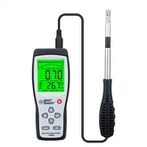Why should I use a wood moisture meter?
This is probably a commonly asked question among first time hygrometer users. While the specific answers to this question may vary by industry, these answers generally relate to quality.
Using a wood moisture meter, you can accurately assess the problems a given sample of wood may be experiencing, such as cracking, shrinkage, splitting, mold growth, etc. When the moisture content of wood is too high (or even too low, in some cases), the quality of the final product suffers.
Using a moisture meter can help you ensure that the moisture content of the wood material you are using is within the correct %MC range to avoid future callbacks.
What are the different types of wood moisture meters?
While there are countless hygrometer models on the market, and new hygrometers appear all the time, they are divided into two categories based on their operation:
Pitch.
Needleless rice.
A pin moisture meter uses two (or more) electrodes to penetrate the wood material to read the %MC of the material using the principle of resistance. In a two-pin meter, one pin emits current and the other pin receives it, and the meter interprets the resistance of the current to the current. Since wood is an insulator and water is a conductor, the less resistance to electrical current, the higher the moisture content of the wood.
Pinless meters, on the other hand, use electromagnetic radio waves to scan a sample of wood beneath the meter's plate. These meters are sometimes called non-invasive moisture meters because they do not have to physically penetrate the wood surface to obtain a reading.
Which type of moisture meter is better?
After asking about the different types of moisture meters, most people also want to know which type of moisture meter is a good one. The answer depends largely on the type of work you're doing, the size of the wood material you're working with, whether it leaves pinholes in the material, and your personal preference.
The needleless meter is fast and will not damage the surface of the material being scanned. Pins, on the other hand, can give you more specific information about the distribution of moisture in the wood.
Many professionals use both types of meters in their work, switching between the two when necessary.






